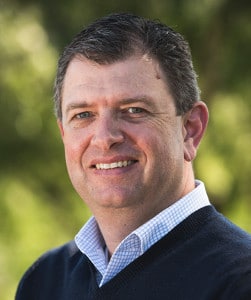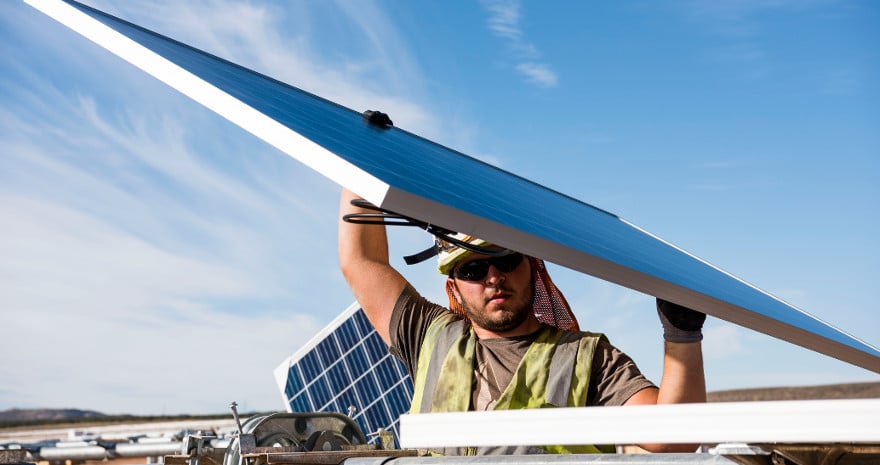Editor’s note: This is the third in our series of interviews on current and anticipated impacts of the Section 201 case. The first two, with Strata Solar and Green Solar Technologies, can be read here and here.
pv magazine: Swinerton is one of the more outspoken companies in terms of supporting SEIA’s position on the Section 201 trade case. Why was it important for your company to show leadership on this issue?
 George Hershman: We’re one of the largest EPC contractors in the country, having built 1.3 GW of work with about 5,000 people throughout the U.S. in 2016. We are a 100% employee-owned company, and this trade case directly affects our employees so it is important for us to get out in front of these sort of job-killing actions.
George Hershman: We’re one of the largest EPC contractors in the country, having built 1.3 GW of work with about 5,000 people throughout the U.S. in 2016. We are a 100% employee-owned company, and this trade case directly affects our employees so it is important for us to get out in front of these sort of job-killing actions.
It was important for us to take a leadership role in telling the story of where the jobs really are in this industry. Everyone likes to point to the blue collar labor force in the manufacturing industry, without realizing that the majority of real jobs are actually in installation. We saw it as something very important for Swinerton to take a leadership role on.
pv magazine: And specifically what sort of effects have you seen due to the Section 201 case to date?
Hershman: We are already seeing projects that are slowing down or being pushed back due to uncertainty in the market, and speculation as to what the availability of modules will be through 2018.
The impacts are being felt now. Our projects are typically 4-6 months in the design and approval process, and we can’t even start the design process without knowing what module we are designing to. Projects that should be in the design and procurement phase now for start-of-construction in early 2018 are pushing back as we determine what will be the availability and cost of modules.
Based on the petitioners’ ask, we are concerned about both quantities and price. Whether or not we will have the ability to even buy modules that will work for our pipeline of work and, if so, whether those modules will be so expensive that the project won’t move forward because of poor economics.
Large EPCs like ourselves are able to drive down costs and build efficiencies into the system through a repetitive process, where our teams are continuously working and our equipment is moving from site to site. Preferably, project teams don’t have a lot of stop and start, which allows us to drive down the overall cost to build the portfolio of work. The kinds of stops and starts we’re experiencing now drive up costs due to inefficiencies. We’ve got equipment that is sitting and not being used, we’ve got teams that we have to demobilize and then remobilize.
It affects the downstream cost of installation because of all the inefficiencies that come with a start and stop process. That’s one of the real challenges, and it’s hard for people to really think beyond just the direct cost to a project. Costs have been driven down on the balance of system because of the efficiencies that companies like ours have built into the system. This case adds inefficiency on top of increased cost of goods.
pv magazine: Leaving aside that very interesting point for a second, can you comment what you are seeing right now in terms of module prices and availability?
Hershman: In the spot market for projects that are immediate – even within the next 120 days where we need modules to fill in our smaller utility or commercial projects – we’re seeing the availability is very, very tight. Module prices have already escalated due to that lack of availability.
It’s not just in the near term that we’ve experienced challenges. In the long term, it’s impossible to get pricing for large utility projects. There is nothing in 2018 that doesn’t have brackets around the price, meaning that it is everybody’s best guess as to what the price could be, but no manufacturer is taking tariff risk.
We can’t pass on that kind of risk, and that’s why owners are not signing up projects. Even now availability has disrupted and driven up costs, because of the concerns of if and when and what day it may be enacted and how quickly. Are you going to be caught with a PO and product on the water and it be impacted by twenty cents? Nobody can manage through that, so it’s affecting module buys today. Unless we have modules where there is 100% certainty that they are on the ground now, it is almost impossible to buy them at a reasonable price.
pv magazine: If significant trade action similar to what the petitioners are requesting is taken, what effect do you expect this to have on Swinerton’s business and the solar EPC sector more broadly?
Hershman: The utility sector will be significantly impacted, as will we. Our business breaks down about 70% utility and about 30% commercial and industrial work. We see that the distributed generation work will continue at a slower scale, but will not be as significantly impacted as the utility sector.
Utility projects are very cost-sensitive. PPA rates have been driven down because of the cost of other energy sources that we are competing with. If costs increase due to tariffs, utility solar projects will not be economic or competitive anymore.
There is no domestic manufacturing of utility-scale modules. Even SolarWorld in its latest press releases regarding the expansion of its plant and the hiring of the 200 employees talks only about the ramp up in their 60-cell high-efficiency PERC module. That is not a product that is used in the utility-scale sector, and it is not cost-effective. We don’t see that anything in this trade action is going to bring significant utility scale product into the market that will offset the huge impact of not having that product available for projects.
Hundreds of megawatts in our portfolio will either be stopped or delayed indefinitely until the economics can work. It’s a question of how long of a runway you have on those PPAs. We have guaranteed COD dates. If we can’t get deliver on the guaranteed COD dates, then those projects go elsewhere – utilities will buy wind or some other generation. It’s not like they are going to hold out until the market can correct – they aren’t going to sit and wait until we can make solar economic again. Those projects are likely gone because utilities need to keep buying. They need to fulfill their requirement for new generation somehow, and they’re not going to sit and wait while we figure out our domestic supply.
There are no economics that say that you can raise the price and somehow it still fits into a PPA that was signed and negotiated based on a cost model that we support easily today. And this model didn’t happen all on the backs of modules. It has happened on efficiencies throughout the supply chain that drive down the cost and allow us to continue to be competitive and grow our market.
Now, with this significant change, all those gains will be lost, and we will therefore not have an economic model to sell to utilities. That is why I have made it a priority to point out that the utility sector is disproportionately affected by this case and is not supported by the petitioners. Those two don’t even align at all.
pv magazine: This is interesting because when I was at SolarWorld’s factories in the previous summer, they were beginning to produce 72-cell modules.
Hershman: They were. By the time they were online, we were late in 2016, and far beyond the movement of the market. I think that they have recognized that their loyal following of suppliers and residential distributors is where their market is — that’s the product that they sell.
Everybody doesn’t have to sell into every market. We have SolarWorld on our office building in San Diego – it’s the right product for the installation. It’s not an issue of product, it’s an issue that their product doesn’t support all markets. There’s a lot of modules in the market that we don’t use in the utility sector because they are specifically built for the residential sector, where density is a much different factor than in a large utility project.
We use 72-cell modules on our commercial applications. SolarWorld has a commercial market for a 72-cell on a carport or something where they are looking for power density and aesthetic qualities – things residential and commercial are more attuned to than a utility sector, which doesn’t necessarily have the same aesthetic demands as commercial clients. A mono-PERC 72-cell module is very good for large-commercial, but it doesn’t necessarily directly feed into the utility sector.
Just because you turn on a 72-cell line doesn’t mean that you make a utility-scale product. There are other issues around it: wire length, frame configuration, among others. We’ve discussed these issues with them in the past and about modifying some aspects to build a more cost-effective module that installs correctly in the utility space. That is not their focus.
If anything breaks through, it has to be that there are real jobs on the line here.
This content is protected by copyright and may not be reused. If you want to cooperate with us and would like to reuse some of our content, please contact: editors@pv-magazine.com.









By submitting this form you agree to pv magazine using your data for the purposes of publishing your comment.
Your personal data will only be disclosed or otherwise transmitted to third parties for the purposes of spam filtering or if this is necessary for technical maintenance of the website. Any other transfer to third parties will not take place unless this is justified on the basis of applicable data protection regulations or if pv magazine is legally obliged to do so.
You may revoke this consent at any time with effect for the future, in which case your personal data will be deleted immediately. Otherwise, your data will be deleted if pv magazine has processed your request or the purpose of data storage is fulfilled.
Further information on data privacy can be found in our Data Protection Policy.